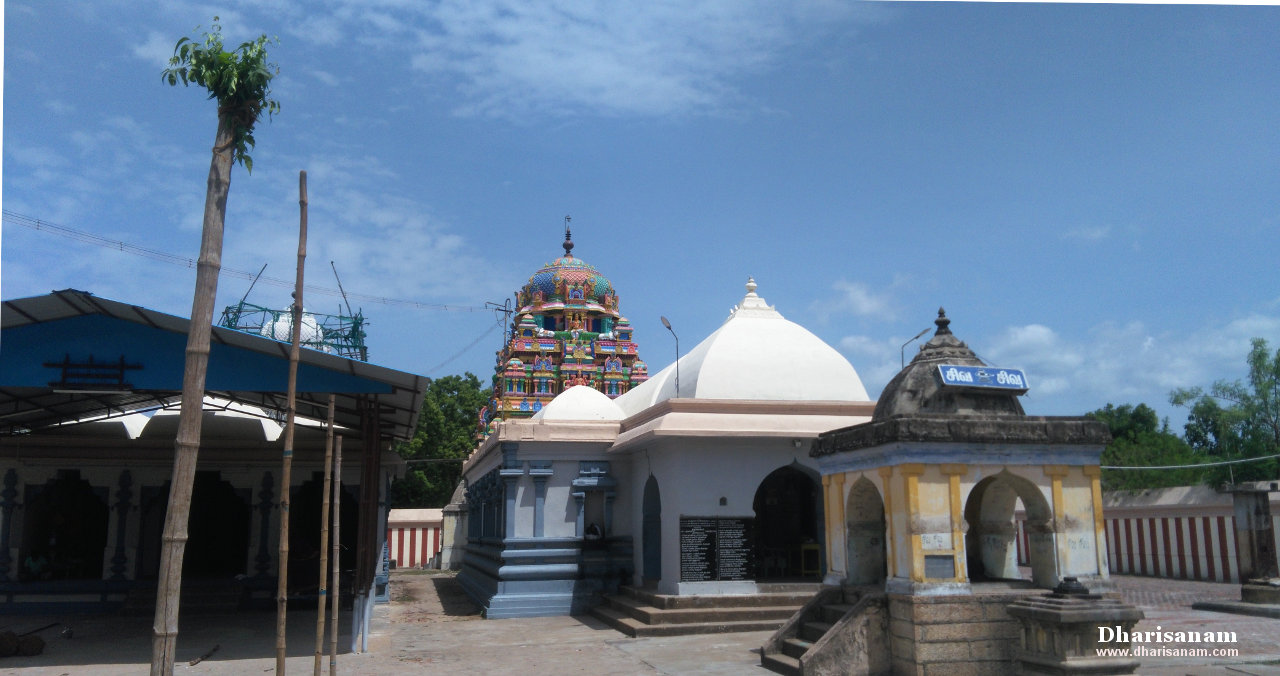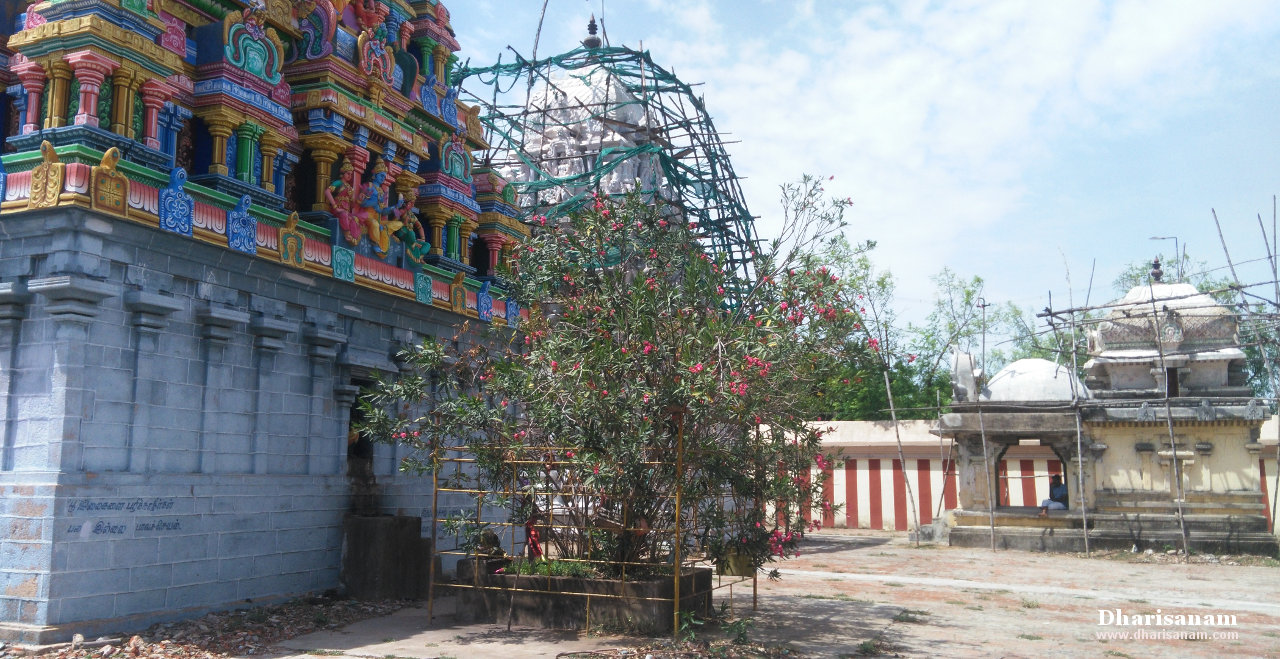Visited on: 11th June, 2018.
Location
Thiru Karaveeram is situated at a distance of about 10 kms from Thiruvarur on the Thiruvarur to Kumbakonam route. Take the diversion road from Vadakandam village and proceed to Karaveeram.
Other Devara Paadal Petra Shiva Sthalams near this place are – Thirukkollamputhur, Peruvelur, Thalaiyaalangadu, Kudavoil (Kudavasal), Thirucheri, Naalur Mayanam, Kaduvaikkarai Puthur (Aandangkoil), Penu Perunthurai, Thiru Naraiyur Siththeecharam, Arisirkarai Puthur, Sivapuram, Karukkudi and Kalayanallur.
General Information
| Moolavar | Sri Brahmapureeswarar, Sri Karaveereswarar, Sri Alarivana Nathar |
| Ambal | Sri Prathyaksha Minnammai, Sri Karaveera Nayagi |
| Theertham (Holy water) | Brahma Theertham / Anavarada Theertham |
| Sthala Vriksham (Sacred Tree) | Pon Alali / Sevvarali |
| Pathigam (Hymn) rendered by | Saint Thirugnanasambanthar-1 |
- This is one of the 276 Devara Paadal Petra Shiva Sthalams and 91st Shiva Sthalam on the Southern bank of the river Cauvery in Chozha Nadu (Thenkarai).
- Lord Shiva in this temple is a Swayambumurthi (self-manifested).
- This east facing temple’s main tower does not have any tiers. In place of the Gopuram, there is a beautiful sculpture depicting Lord Shiva and Goddess Parvathy.
- This temple has only one corridor. It does not have a flag post (Dwajasthambam).
- The last consecration ceremony (Maha Kumbabishekam) took place on 22.08.1997.
History of the Temple
This ancient temple is situated on the southern bank of the river Vettaru.
According to legend, in ancient times, this region was a forest densely covered with Karaveeram trees. This temple’s Sthala Viruksham is “Pon Alari” / “Sevvarali” (Karaveeram), hence this place gets the name Karaveeram. However, now this place is known as Vadakandam Karaiyapuram.
Another reason why this village got the name Karaveeram is because it is believed that a donkey (“karam” in Tamil) worshiped the lord here.
This temple is under the administrative control of the Hindu Religious and Charitable Endowments Department of Government of Tamil Nadu (HR&CE).



Legend
It is believed that Lord Brahma worshiped Lord Shiva here. Hence Lord Shiva here is praised “Sri Brahmapureeswarar”.
The legend of this temple is that Goddess Parvathy is waiting in the main hall for Lord Shiva to return from his stroll in the village.
Another legend is that Lord Shiva created and installed a Shivalingam here. The lord advised Sage Gowtama to take care of that Shivalingam. The sage obeyed the lord’s advice, stayed here and performed penance. Pleased with his penance, Lord Shiva granted him his darshan and asked him about his wish. The sage prayed to the lord that after his death, he should become this temple’s sacred tree. The lord granted him this boon. Later the saint attained salvation here and his burial place (“Jeeva Samadhi”) is inside the temple complex. It is also believed that he is present here in the form of the Sthala Viruksham (Pon Alari tree). There is also a separate shrine for him in this temple.

Another legend associated with this temple is that of a donkey. The donkey did penance here to receive the darshan of Lord Shiva but it failed in its attempt. Frustrated, the donkey decided to jump into the sea and went up to Nagore. It was about to fall in to the sea but heard a sound and turned back. To its surprise, Lord Shiva was there to grant his darshan. Lord Shiva blessed the donkey with salvation. There is no flag post in this temple. There is also no construction that obstructs the path from this temple till the sea shore at Nagore (about 35 kms away).
Deities in the temple
Other than the shrines of Lord Shiva and Goddess Parvathy, shrines and idols of Vinayakar, Murugan with his consorts, Suryan, Chandan, Saneeswarar, Bairavar, Nalvar, Nava (nine) Shivalingams, Nagars, Sapthamathas and Chandikeswarar can be seen in the main hall and in the corridor.
In the “koshtam” (place surrounding the sanctum sanctorum), idols of Dakshinamurthy, Mahavishnu, Brahma and Durgai can be seen.







Salient Features
In this temple, shrines of both Lord Shiva and Goddess Parvathy are facing the east direction. Goddess Parvathy’s shrine is on the right side of Lord Shiva’s shrine. This is considered to symbolise their wedding posture.
Both Lord Shiva and Goddess Parvathy’s idols are about six and a half feet tall. Both these sanctum towers are very tall and there are many sculptures on it.
Lord Vinayakar of this temple is praised as Lord Raja Ganapathy.
Saint Thirugnanasambanthar reached this place at night. Hence, he stayed back and worshiped the lord on the next morning. In all the stanzas of his hymn about this temple, he mentions that by worshiping the lord here, devotees will be absolved from all their sins.
The front hall (Mandapam) of this temple is designed to look like the forehead of a bat (“Vovval Nethi Mandapam”). This looks very beautiful.


Greatness of this temple
It is considered auspicious for women to water the Sthala Viruksham (Pon Alari) and worship Lord Brahmapureeswarar on new moon days. Devotees believe that by doing so, their marriage proposal will be finalised soon.
Devotees also consider it auspicious to stay a night in this place before worshiping the lord, just like Saint Thirugnanasambanthar did. They believe that by doing so they will be freed from all kind of troubles and they will be blessed with prosperity.
Important Festivals
Some of the important festivals celebrated in this temple are –
Vinayakar Chaturthi in the Tamil month of Aavani (Aug-Sept),
Thiruvadhirai in the Tamil month of Markazhi (Dec-Jan),
Makara Sankranthi in the Tamil month of Thai (Jan-Feb),
Shivrathri in the Tamil month of Masi (Feb-Mar) and
Panguni Uthiram in the Tamil month of Panguni (Mar-Apr).
Pradosham is also observed regularly here.
Special poojas are performed on new moon days. This attracts many devotees.
Temple Timings
From 08:30 AM to 12:00 Noon and from 05:00 PM to 08:30 PM.
Temple Address
Sri Brahmapureeswarar/Sri Karaveeranathar Temple,
Karaiyapuram (Thiru Karaveeram),
Manakkal Iyyampettai-Post,
Vadakandam-Via,
Kudavasal-Taluk,
Thiruvarur-District,
Tamil Nadu – 610 104.
Tele: +91 - 4366 - 241 978.
This temple’s priest Sri Saravana Gurukkal can be contacted at +91-97878 53460.






Pathigam (Hymn) with English transliteration and Tamil meaning.
Saint Thirugnanasambanthar visited this temple and sang this Pathigam.
Devotees visiting this temple should make it a practice to recite this Pathigam.
Thirumurai No. 1.058.
அரியும் நம்வினை யுள்ளன ஆசற
வரிகொள் மாமணி போற்கண்டம்
கரிய வன்திக ழுங்கர வீரத்தெம்
பெரிய வன்கழல் பேணவே.
“Ariyum namviṉai yuḷḷaṉa āsaṟa
varikoḷ māmaṇi pōṟkaṇṭam
kariya vaṉthika zhuṅkara vīraththem
periya vaṉkazhal pēṇavē”.
வரிகள் அமைந்த சிறந்த நீலமணி போலக் கண்டம் கறுத்தவனாய், விளங்கும் திருக்கரவீரத்தில் எழுந்தருளியுள்ள எம்பெருமானாகிய இறைவன் திருவடிகளைத் துதித்தால் நம் வினைகளாக உள்ளன யாவும் முற்றிலும் கழியும்.
தங்கு மோவினை தாழ்சடை மேலவன்
திங்க ளோடுடன் சூடிய
கங்கை யான்திக ழுங்கர வீரத்தெம்
சங்க ரன்கழல் சாரவே.
“Thaṅku mōviṉai thāzhsaṭai mēlavaṉ
thiṅka ḷōṭuṭaṉ chūṭiya
gaṅgai yāṉthika zhuṅkara vīraththem
saṅka raṉkazhal sāravē”.
தாழ்ந்து தொங்கும் சடைமுடிகளை உடைய உயர்ந்தோனாய் இளம்பிறையோடு கங்கையை உடனாகச் சூடிய, திருக் கரவீரத்தில் விளங்கும் சங்கரன் திருவடிகளை வழிபட்டால் நம்மைப் பற்றிய வினைகள் தங்கா.
ஏதம் வந்தடை யாஇனி நல்லன
பூதம் பல்படை யாக்கிய
காத லான்திக ழுங்கர வீரத்தெம்
நாதன் பாதம் நணுகவே.
“Ētham vanthaṭai yā'iṉi nallaṉa
pūtham palpaṭai yākkiya
kātha lāṉthika zhuṅkara vīraththem
nāthaṉ pātham naṇukavē”.
நல்லனவாகிய பூத கணங்களைப் பல்வகைப் படைகளாக அமைத்துக் கொண்டுள்ள அன்பு வடிவினனும் விளங்கும் திருக்கரவீரத்தில் எழுந்தருளிய எம் நாதனுமான சிவபெருமான் திருவடிகளை அடைவோரைத் துன்பங்கள் வந்தடையமாட்டா.
பறையும் நம்வினை யுள்ளன பாழ்பட
மறையும் மாமணி போற்கண்டம்
கறைய வன்திக ழுங்கர வீரத்தெம்
இறைய வன்கழல் ஏத்தவே.
“Paṟaiyum namviṉai yuḷḷaṉa pāzhpaṭa
maṟaiyum māmaṇi pōṟkaṇṭam
kaṟaiya vaṉthika zhuṅkara vīraththem
iṟaiya vaṉkazhal ēththavē”.
நீலமணி போலக் கண்டத்தில் கறையுடையவனும், விளங்கும் திருக்கரவீரத்தில் உறையும் எம் இறைவனுமாகிய பெருமான் திருவடிகளை ஏத்த நம் வினைகள் நீங்கும். சஞ்சிதமாக உள்ளவும் மறையும்.
பண்ணி னார்மறை பாடலன் ஆடலன்
விண்ணி னார்மதி லெய்தமுக்
கண்ணி னான்உறை யுங்கர வீரத்தைத்
நண்ணு வார்வினை நாசமே.
“Paṇṇi ṉārmaṟai pāṭalaṉ āṭalaṉ
viṇṇi ṉārmathi leythamuk
kaṇṇi ṉāṉuṟai yuṅkara vīraththaith
naṇṇu vārviṉai nāsamē”.
சந்த இசையமைப்புடன் கூடிய வேதங்களைப் பாடியும் ஆடியும் மகிழ்பவரும், வானகத்தில் சஞ்சரித்த மும்மதில் களையும் எய்தழித்த மூன்றாம் கண்ணை உடையவரும் ஆகிய சிவபிரானார் எழுந்தருளிய திருக்கரவீரத்தை அடைவார் வினைகள் நாசமாம்.
நிழலி னார்மதி சூடிய நீள்சடை
அழலி னாரழ லேந்திய
கழலி னாருறை யுங்கர வீரத்தைத்
தொழவல் லார்க்கில்லை துக்கமே.
“Nizhali ṉārmathi chūṭiya nīḷsaṭai
azhali ṉārazha lēnthiya
kazhali ṉāruṟai yuṅkara vīraththaith
thozhaval lārkkillai thukkamē”.
ஒளி பொருந்திய பிறைமதியைச்சூடிய நீண்ட சடைமுடியினரும், அழலைக் கையில் ஏந்தியவரும் வீரக்கழலை அணிந்தவரும் ஆகிய சிவபெருமான் எழுந்தருளிய திருக்கரவீரத்தைத் தொழவல்லவர்கட்குத் துக்கம் இல்லை.
வண்டர் மும்மதில் மாய்தர எய்தவன்
அண்டன் ஆரழல் போலொளிர்
கண்ட னாருறை யுங்கர வீரத்துத்
தொண்டர் மேல்துயர் தூரமே.
“Vaṇṭar mum'mathil māythara eythavaṉ
aṇṭaṉ ārazhal pōloḷir
kaṇṭa ṉāruṟai yuṅkara vīraththuth
thoṇṭar mēlthuyar thūramē”.
தீயவர்களாகிய அசுரர்களின் முப்புரங்களும் அழிந்தொழியுமாறு கணை எய்தவரும், அனைத்து உலகங்களின் வடிவாக விளங்குபவரும், விடம் போல ஒளிவிடும் கண்டத்தை உடைய வரும் ஆகிய சிவபிரான் எழுந்தருளியுள்ள திருக்கரவீரத்துத் தொண்டர்களைப் பற்றிய துயரங்கள் தூர விலகும். அழல் - தீப்போன்ற கொடிய விடம்.
புனலி லங்கையர் கோன்முடி பத்திறச்
சினவ லாண்மை செகுத்தவன்
கனல வன்னுறை கின்ற கரவீரம்
எனவல் லார்க்கிட ரில்லையே.
“Puṉali laṅkaiyar kōṉmuṭi paththiṟach
chiṉava lāṇmai sekuththavaṉ
kaṉala vaṉṉuṟai kiṉtṟa karavīram
eṉaval lārkkiṭa rillaiyē”.
கடலால் சூழப்பட்ட இலங்கை மக்களின் தலைவனாகிய இராவணனின் தலைகள் பத்தும் நெரியுமாறு செய்து, கோபத்தோடு கூடிய அவனது ஆண்மையை அழித்தவனாய், எரிபோலும் உருவினன் ஆகிய சிவபிரான் எழுந்தருளிய கரவீரம் என்று சொல்ல வல்லார்க்கு இடர் இல்லை.
வெள்ளத் தாமரை யானொடு மாலுமாய்த்
தெள்ளத் தீத்திர ளாகிய
கள்ளத் தான்உறை யுங்கர வீரத்தை
உள்ளத் தான்வினை ஓயுமே.
“Veḷḷath thāmarai yāṉoṭu mālumāyth
theḷḷath thīththira ḷākiya
kaḷḷath thāṉuṟai yuṅkara vīraththai
uḷḷath thāṉviṉai ōyumē”.
நீரில் தோன்றும் தாமரை மலர் மேல் உறையும் நான் முகனோடு திருமாலும் உண்மையைத் தௌயுமாறு ஒளிப் பிழம்பாகத் தோன்றி அவர்கள் அறியாவாறு கள்ளம் செய்தவனாகிய சிவபிரான் உறையும் திருக்கரவீரத்தை நினைந்து போற்ற வினைகள் நீங்கும்.
செடிஅ மண்ணொடு சீவரத் தாரவர்
கொடிய வெவ்வுரை கொள்ளேன்மின்
கடிய வன்னுறை கின்ற கரவீரத்
தடிய வர்க்கில்லை யல்லலே.
“Seṭi'a maṇṇoṭu sīvarath thāravar
koṭiya vevvurai koḷḷēṉmiṉ
kaṭiya vaṉṉuṟai kiṉtṟa karavīrath
thaṭiya varkkillai yallalē”.
முடைநாற்றம் வீசும் அமணர்களோகாவியாடை அணிந்து திரியும் புத்தர்கள் ஆகியோர்தம் கொடிய வெம்மையான உரைகளை மெய்யெனக் கொள்ளாதீர். அனைத்துலகையும் காத்தருள் கின்றவனாகிய சிவபிரான் உறைகின்ற திருக்கரவீரத்து அடியவர்க்கு அல்லல் இல்லை.
வீடி லான்விளங் குங்கர வீரத்தெம்
சேடன் மேற்கசி வால்தமிழ்
நாடு ஞானசம் பந்தன சொல்லிவை
பாடு வார்க்கில்லை பாவமே.
“Vīṭi lāṉviḷaṅ kuṅkara vīraththem
sēṭaṉ mēṟkasi vālthamizh
nāṭu gñāṉasam banthaṉa sollivai
pāṭu vārkkillai pāvamē”.
அழிவில்லாதவனாக விளங்கும் திருக்கரவீரத்துப் பெரியோன் மேல் அன்புக்கசிவால் தமிழை விரும்பும் ஞானசம்பந்தன் சொல்லிய இத்திருப்பதிகப் பாடல்களாகிய இவற்றைப் பாடுவோர்க்குப் பாவம் இல்லை.







